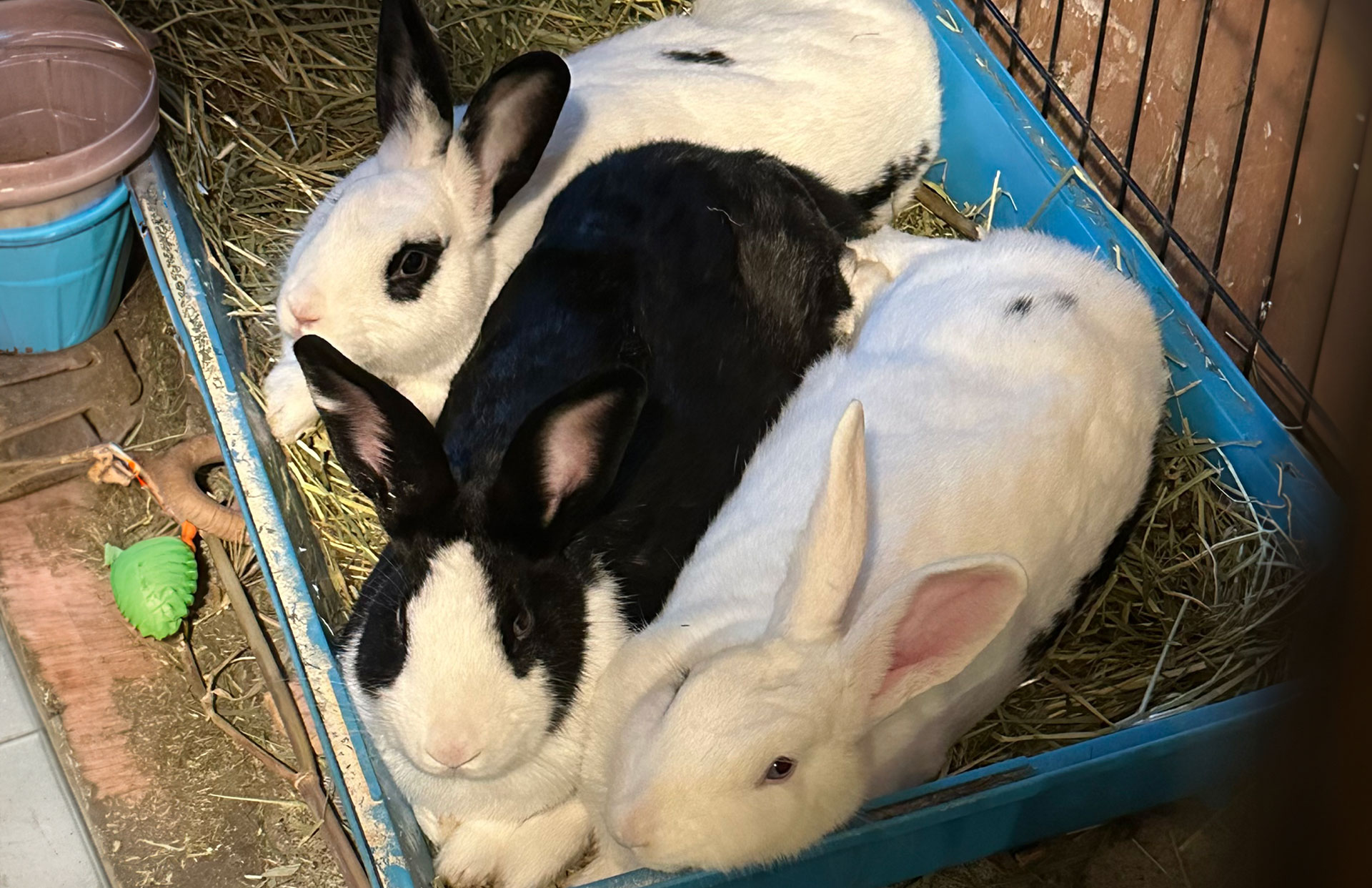Editor’s note: Oakland Street Bunz is a rabbit rescue group focused on ensuring loose bunnies get to safety as well as educating the public about rabbit caregiving needs and appropriate rehoming or shelter relinquishing. OSB works with area shelters and have rabbits available for adoption. Fosters and adopters are desperately needed! Please reach out via Instagram at @OaklandStreetBunz and via Facebook at Jessica Peters—website coming soon!
It often starts with a late-night text message, perhaps just a blurry photo and a pin drop or cross streets. Sometimes it’s my name being flagged on a Nextdoor post or a share of a Facebook post, but regardless of where the “lost rabbit” message comes from, the urgency is the same. The clock is ticking for these poor souls as we know that domesticated rabbits have zero ability to survive outside on the loose. They are threatened by predators of all types—from dogs and hawks to cars and horrific treatment by cruel people—but they also struggle to find food and water to sustain themselves while awaiting rescue.
Sadly, when I arrive to a park site, it’s not uncommon to find a rabbit or two already consumed by wildlife. While finding dumped rabbits in parks is common, I also find a large percentage of rabbits dumped in urban areas on residential streets. When I arrive at an urban site, often some of the rabbits have already passed due to being hit by cars. The urgency is very, very real, and compassionate action is required to save these dumped rabbits as rapidly as possible.

While some of the public or neighbors are obviously aware this domestic rabbit abandonment is dangerous and will post on social media or text me and attempt to help with the rescue, sadly many people are not even aware these rabbits are in danger. I often hear “it’s eating grass,” “the bunny is fine,” and even “we like to see them be free.” I’ve been called cruel and mean many times in my attempts to save loose rabbits. It’s difficult to explain that these rabbits are definitely not fine. They are suffering and in need of immediate help, even if their nature as a prey animal species propels them to “look fine” no matter the tragic or dangerous circumstances.
If I’m not able to come to a site right away, which is often true given the volumes of sites and locations, I ask whoever texted/messaged/posted to provide some produce like kale, cilantro, basil, parsley or lettuce in a non-street or road area nearby the sighting. I find there’s value in acclimating the rabbits to a particular area in hopes of easier capture and rescue in the future. Using strong smelling herbs and bananas to lure can also be helpful as you attempt capture.
Capture techniques vary based on the site, from x-pens to humane traps to nets. Using x-pens to cordon off and capture rabbits is likely the method most are familiar with. It’s incredibly useful both alone and in conjunction with other tools and techniques. The general idea is to use the x-pens to section off an area and reduce the volume of directions for the rabbits to flee, ideally trapping them entirely inside a circle of x-pens so a helper can grab them and get them into a carrier as easily as possible.
Nets are somewhat less common and certainly have the potential to be dangerous to rabbits if used incorrectly. For this reason, I’m very careful about instructing volunteers and helpers about how to use nets. It’s extremely important to only use nets to hold a rabbit very briefly to the ground to secure them in your arms. I instruct helpers to immediately hold the rabbit down inside the net by the shoulders and rear, then essentially press themselves down carefully to keep the rabbits secure while another helper arrives. Then both (or more) helpers will make sure the rabbit is fully secure in the net while slowly and carefully extracting the rabbit. It’s crucial to make sure their legs and toenails don’t get entangled in the netting and to disentangle slowly and carefully while maintaining a secure hold on the rabbit. This is why multiple helpers are necessary for the safety of the rabbit.
While incredibly useful, careful caution is also necessary when using humane traps. They must be checked with great frequency to ensure the safety of the rabbits and other wildlife. That said, I’ve only had accidental traps of community cats, no wildlife—and then only twice in many years of using traps. As with luring rabbits to stay nearby, strong smelling herbs and bananas are particularly useful for “baiting” the traps.

Sometimes it’s necessary to camouflage the traps, particularly in natural environments like parks. I will often just pull up nearby plants and leaves and attempt to disguise the trap. Traps should be placed on pathways & tunneling areas the loose rabbits are known to use. If in an urban or residential area, traps are best placed alongside curbs, below parked cars (with the consent of owner) and in other locations where the trap is flush with an existing structure or car or human-made form in areas where the rabbits have been seen to travel. When a rabbit has entered and triggered the trap, it’s important to bring the whole trap to a closed vehicle to transfer the rabbit from trap to carrier. If that’s not possible, it’s best to keep the rabbit inside the trap while heading to animal shelter or rescue facility to prevent accidental escape.
Finally, while I know that the language “dumped” may sound rough to fellow rabbit lovers, I find the language “abandoned” to be too sterile. These animals are literally dumped like trash. While these rescues can often be difficult, frustrating, or even dangerous in some locations, they are also lifesaving. It can require lots of patience, perseverance, and athleticism but for every single rabbit saved, it’s well worth your efforts.
Reviewed by HRS staff
Author: Jessica Peters of Oakland Street BunzPhoto Credit: Photos provided by Jessica Peters
Journal Issue: House Rabbit Journal, Fall 2023





